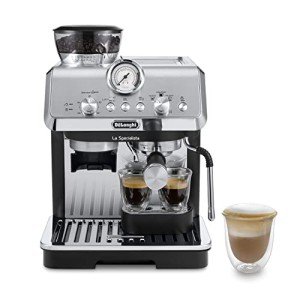Energy-Efficient Espresso Machines: A Comprehensive Guide
In the world of coffee enthusiasts, espresso machines are frequently considered as necessary home appliances for developing rich, aromatic coffee. However, the energy intake related to these machines can result in increased energy costs and environmental concerns. As customers end up being more eco-conscious, energy-efficient espresso machines have actually become a popular choice. This article aims to check out the functions, advantages, and alternatives offered in energy-efficient espresso machines, assisting coffee enthusiasts make notified choices.
What Makes an Espresso Machine Energy-Efficient?
Energy-efficient espresso machines are developed to decrease energy intake while preserving ideal efficiency. Numerous functions add to the energy performance of these machines:
- Insulation: High-quality insulation helps keep heat, reducing the energy required to preserve optimum brewing temperatures.
- Smart Technology: Many modern machines are geared up with programmable settings that allow users to arrange brewing times and switch to standby mode when not in use.
- Quick Heat-up Time: Energy-efficient espresso machines often use innovative heating technologies, such as thermoblocks or PID controllers, to heat water quickly.
- Low Wattage: Machines that operate at lower wattages take in less energy overall, making them more effective.
- Auto Shut-off: Automatic shut-off features guarantee that the machine turns off after a certain duration of inactivity, more reducing energy waste.
Benefits of Energy-Efficient Espresso Machines
Investing in an energy-efficient espresso machine can use numerous advantages:
- Cost Savings: Over time, lower energy consumption can cause lowered electricity costs.
- Ecological Impact: Using less energy minimizes carbon footprints, making these machines a more sustainable option for environmentally mindful customers.
- Enhanced Performance: Many energy-efficient models also provide exceptional brewing innovations, leading to better-tasting espresso.
- Resilience: Typically, energy-efficient machines are built with high-quality elements, resulting in greater durability.
Functions to Consider
When choosing an energy-efficient espresso machine, numerous features ought to be taken into account:
- Type of Machine: Options consist of manual, semi-automatic, and totally automatic models, each with varying degrees of user control and automation.
- Brew Quality: Look for machines that make use of high-quality brewing systems to make sure optimum flavor extraction.
- Upkeep: Some machines have self-cleaning features that can save energy and effort in upkeep.
- Capacity: Depending on individual or household size, machine capacity can affect energy intake, with bigger machines often needing more power.
Popular Energy-Efficient Espresso Machines
The marketplace provides a range of energy-efficient espresso machines accommodating various requirements and preferences. Below are some notable models:
| Brand | Design | Secret Features | Energy Consumption |
|---|---|---|---|
| Breville | Barista Express | Integrated grinder, PID temperature control, quick heat-up. | Low |
| DeLonghi | EC155 | Compact size, easy to use, resilient build. | Moderate |
| Rancilio | Silvia | Durable design, exceptional temperature stability, and has a low environmental effect. | Moderate |
| Gaggia | Timeless | Trusted manual operation, durable brass elements, and efficient steaming capability. | Low |
| Jura | E8 | Completely automatic, smart functions, and a detachable brew group for simple cleansing. | Low |
Tips for Optimal Energy Efficiency
Aside from selecting an energy-efficient model, consumers can adopt numerous practices to take full advantage of energy effectiveness:
- Preheat: If your machine has a pre-heating function, use it to make sure that the optimal temperature is reached quickly before brewing.
- Switch off After Use: Always shut off the machine after brewing or use machines with vehicle shut-off functions.
- Routine Maintenance: Keep the machine well-kept to ensure it operates efficiently and successfully.
FAQs About Energy-Efficient Espresso Machines
1. Are energy-efficient espresso machines more costly?
While the initial investment may be greater for energy-efficient designs, the long-term savings on electricity bills can balance out the preliminary cost. Additionally, lots of energy-efficient machines included innovative functions that enhance the brewing experience.
2. How do I understand if an espresso machine is energy-efficient?
Search for indicators such as Energy Star accreditation, user reviews, and specs relating to wattage and heat-up time. Machines with specific functions targeted at decreasing energy usage are typically designed for better effectiveness.
3. Can I use an energy-efficient espresso machine for other coffee designs?
Many energy-efficient espresso machines offer flexibility, permitting users to brew various coffee styles beyond espresso, such as lattes and coffees, by incorporating steaming abilities.
4. Do energy-efficient models compromise quality for efficiency?
Not necessarily. Numerous energy-efficient espresso machines are equipped with high-quality brewing innovation that can improve flavor extraction while reducing energy intake.
5. What maintenance is needed for energy-efficient espresso machines?
Regular maintenance includes cleaning up the machine, descaling when required, and regularly examining seals and gaskets to guarantee ideal performance and energy effectiveness.
Energy-efficient espresso machines represent a best mix of efficiency, cost savings, and ecological responsibility. By thinking about Sleek Espresso Machines , benefits, and brand names, consumers can pick a model that fits their distinct preferences while contributing favorably to the environment. As the pattern toward sustainable living grows, the popularity of energy-efficient appliances, including espresso machines, is most likely to continue its upward trajectory, offering coffee enthusiasts a guilt-free way to enjoy their everyday dose of espresso.

